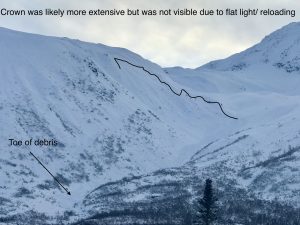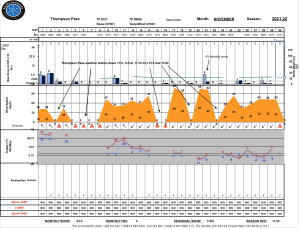Valdez
Above 4,000ftConsiderable
2,000 to 4,000ftConsiderable
Below 2,000ftConsiderable
Degrees of Avalanche Danger
Avalanche Problems
Problem 1
Triggering a wind slab avalanche 2- 3 feet deep is likely today on lee aspects (SE-NW) of terrain recently exposed to wind. Wind slabs that were 2 feet deep were found to be very reactive on lee aspects of test slopes in the Catchers Mitt area on 12/14. These were failing on faceted snow, meaning they will likely stay reactive longer than your typical windslab. Visibilities were limited in the area on 12/14. Although, several D2-2.5 natural avalanches were observed on southerly aspects with average crown depths of 3 feet with max depths of 6 feet observed. Windslabs were generally found to be 4 finger to 1 finger in hardness with shooting cracks traveling up to 20 feet in length. The hazard for this avalanche problem will be less in areas that were protected from the recent outflow wind event beginning 12/11. In these areas triggering a persistent slab avalanche (see problem 2) will be likely in terrain steeper than 32°.
Wind slab avalanches will have the potential to step down into deeper faceted layers in our snowpack, (see problem 2) and produce larger avalanches. Avoid recently wind loaded slopes in terrain steeper than 32°. The hazard for this avalanche problem will remain steady for the next 24 hours.
Likelihood:
- Almost Certain
- Very Likely
- Likely
- Possible
- Unlikely
Size:
- Historic
- Very Large
- Large
- Small
Trend
- Increasing
- Steady
- Decreasing
Problem 2
There is a 2-3+ foot deep slab sitting on the November facets. These facets have continued to show easy to moderate propagation results in ECT and PST stability tests. Red flags such as shooting cracks, large collapses and natural avalanches have been present in the Thompson Pass area lately. This is a bullseye indicator that our persistent avalanche problem is still active.
Very strong northeast winds are loading lee aspects, further stressing facets in these areas. In areas exposed to wind, the slab overlying the November facets has variable depths. These range from scoured down to the facets (no slab) on windward aspects to 2-4 feet deep on lee aspects (dense wind slabs). In these areas the avalanche problem is confined to specific areas (lee aspects).
In areas sheltered from the wind the slab thicknesses are more uniform. In these area the persistent avalanche problem is widespread. A skier or snowmachine is likely to directly affect these weak layers and may trigger avalanches directly or remotely in terrain steeper than 32°. At the present moment this problem layer is 2-3 feet deep in most locations. The depth of the current slab has good attributes and bad. The good thing for us at the present, is that the weak layer is still shallow enough that red flags such as collapsing and shooting cracks are still happening which should alert us to the danger. The bad thing is that we are still able to easily affect this layer and human triggered avalanches remain likely in terrain steeper than 32° that could injure, bury or kill a person.
The only successful mitigation practices for a persistent slab avalanche problem are patience, and a conservative approach in choosing terrain. Good protocols are very important as well during this type of avalanche problem ie: only exposing one person at a time to an avalanche prone slope, good communication and having an escape route should a slope fail.
Photo of Remote triggered/sympathetic avalanches on 12/8
1cm+ chained facet found buried 40 cms (16″) on Catchers Mitt 3500′ SE aspect.


Likelihood:
- Almost Certain
- Very Likely
- Likely
- Possible
- Unlikely
Size:
- Historic
- Very Large
- Large
- Small
Trend
- Increasing
- Steady
- Decreasing
Avalanche Activity
12/14- Several natural avalanches were observed although poor visibility prevented a full view of the action. The most notable natural was observed in Nicks Happy Valley on a NW aspect ~4000′. Crown depth was not visible. Debris ran down the valley and piled up at the typical snowmachine pickup.

12/8- Large remote trigger/ sympathetic avalanche event occurred 12/8 with avalanches extending from Gully 1 to Nicks. Avalanches were soft slabs that ranged in size from D1-D3. Over 10 separate avalanches were counted with crown depths averaging 2-3′. One avalanche had a crown length of half a mile while another was triggered over a mile away from the point of collapse. See observation section for full report and more photos.

12/7- Only a few natural avalanches were noted during the last storm. It is likely there were more during the storm, but crowns may have been filled in by subsequent wind and snow.
D2’s on Town mountain was observed ~3000′
A couple of D2’s were noted in N. Oddessey gully and Big Oddessey.
D2 on 40.5 mile peak ~5500′.
12/2-12/3- Several natural D2 avalanches were noted on south aspects of Three pigs, Hippie Ridge and Averys. These windslab avalanches originated between 4000-5500 feet elevation.

Weather
NWS Watches and Warnings
...WIND CHILL ADVISORY REMAINS IN EFFECT UNTIL 5 PM AKST THIS AFTERNOON THROUGH THOMPSON PASS... * WHAT...Very cold wind chills. Wind chills as low as 40 below zero. * WHERE...Thompson Pass. * WHEN...Until 5 PM AKST this afternoon.
Point forecast for Thompson Pass
Detailed forecast for Thompson Pass (mid elevation 2000-4000′)
DATE WEDNESDAY 12/15 THURSDAY 12/16
TIME (LT) 06 12 18 00 06 12 18 00 06
CLOUD COVER CL FW BK OV OV OV OV OV OV
CLOUD COVER (%) 5 10 55 70 75 95 95 90 80
TEMPERATURE -1 -3 0 5 10 16 17 17 14
MAX/MIN TEMP 4 -5 17 12
WIND DIR NE NE NE E SE SE E E NE
WIND (MPH) 21 20 16 5 5 9 9 8 4
WIND GUST (MPH) 51 51 40
PRECIP PROB (%) 0 0 0 30 50 90 90 90 70
PRECIP TYPE S S S S S S
12 HOUR QPF 0.00 0.01 0.10 0.13
12 HOUR SNOW 0.0 0.0 1.2 2.1
SNOW LEVEL (KFT)0.0 0.0 0.0 0.0 0.0 0.0 0.0 0.0 0.0
Snow and Temperature Measurements
| Date: 12/15 | 24 hr snow | HN24W* | High Temp | Low Temp | Weekly SWE (Monday- Sunday) | December Snowfall | Season Snowfall | HS (Snowpack depth) |
| Valdez | Trace | 0 | 26 | 14 | .1 | 48 | 72 | 22 |
| Thompson Pass | N/O | 0 | 4 | -8 | .1 | ~34 | 153 | 24 |
| 46 Mile | 1 | .05 | 2 | -5 | .25 | 25 | 25** | 20
|
All snowfall measurements are expressed in inches and temperature in Fahrenheit. 24 hour sample period is from 6am-6am.
* 24 hour snow water equivalent/ SWE.
** Season total snowfall measurements for 46 mile began December 1st.
Season history graphs for Thompson Pass

Click on links below to see a clear and expanded view of above Season history graphs
Additional Information
Winter weather began early this season, with valley locations receiving their first snowfall on the last day of Summer (September 21st). Following this storm, above average temperatures and wet weather occurred from late September through early November. During this time period Thompson Pass received 96 inches of snowfall by November 7th and Valdez recorded 7.73″ of rain.
After the 7th of November our region experienced a sharp weather pattern change. Temperatures dropped below seasonal norms and snowfall became infrequent. Between the time frame of November 7th- November 28th Thompson Pass only reported 19″ of snow with 1.1″ of Snow water equivalent (SWE). Temperatures remained below 0° F for most of the period. This cold/dry weather caused significant faceting of the snowpack, with poor structure the result.
Moderate snowfall returned to our area the last day of November and deposited 6-12 inches of new snow. The amount varied depending upon the locations’ proximity to the coast. As the storm exited on the 2nd of December it was quickly replaced by moderate to strong northeast winds.
On 12/5-12/6 Valdez received 2 feet of new snow with Thompson Pass reporting 16″. Blaring red flags like collapsing, shooting cracks and propagation in stability tests were immediately present. On 12/8 a significant remote/ sympathetic avalanche event occurred from Gully 1 through Nick’s Happy Valley.
Strong outflow winds began on 12/11 with periods of light snowfall. This has caused slab thicknesses to become variable in areas exposed to NE winds.
Announcements
Click the + Full Forecast button below for a list of current avalanche problems, travel advice, weather resources and more.
Help to improve your local avalanche center and contribute an observation to the website. You can also contact me directly at [email protected] (907)255-7690.

